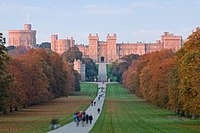Castles of England/Berkshire
There are two castles in Berkshire.
| Name |
Type |
Date |
Condition |
Ownership / Access |
Notes (Key) |
|---|---|---|---|---|---|
| Donnington Castle | Castle | c.1386 | Fragment | Built by Richard Abberbury the Elder, destroyed in Civil War, gatehouse survives. | |
| Windsor Castle | Keep and bailey | 12–19th century | Intact | Royal palace | Restored and extended by Wyatt and Wyattville, 1800–30. |
Donnington Castle
[edit | edit source]

Donnington Castle is a ruined medieval castle, situated in the small village of Donnington, just north of the town of Newbury in Berkshire. It was built by its original owner, Richard Abberbury the Elder, under a licence granted by Richard II in 1386. The surviving castle gatehouse dates from this time. The castle was subsequently bought by Thomas Chaucer, the son of the poet Geoffrey Chaucer, as a residence for his daughter Alice, who later became Duchess of Suffolk. This family later fell out with the Tudor monarchs, and the castle became a Royal property. Both King Henry VIII and Queen Elizabeth I visited Donnington Castle, in 1539 and 1568 respectively.
The castle was originally built in a rectangular form, with a curtain wall cornered by four round towers, two square wall towers, and a substantial gatehouse, constructed around a courtyard. The courtyard buildings were probably of timber construction and possibly included a hall, kitchen, and guest lodgings.
By the time the English Civil War broke out in 1643, the castle was owned by the Parliamentarian John Packer family but after the First Battle of Newbury it was taken for the King, Charles I, and held by Sir John Boys. They quickly built defences on the slopes of the hill in a star shape. The projections were for gun emplacements, the scarps and platforms of which survive today. Despite being besieged for most of the war, it had to be relieved by the King on two occasions, the castle succeeded in guarding the major routes from London to the West Country and Oxford to Southampton. During the Second Battle of Newbury, the castle was able to hold off the Parliamentary attackers. Finally, after an eighteen month siege, the garrison, after obtaining the Kings permission, abandoned the damaged castle and were allowed to rejoin Royalist forces in Wallingford.
In 1646 Parliament voted to demolish the castle leaving only the gatehouse remaining, which was then restored to John Packer. All that remains of the castle today is the substantial four towered gatehouse, and the surrounding earthworks.
The castle is now in the care of English Heritage and is a scheduled ancient monument number 233041. The gatehouse is two stories high and roofed at battlement level. The external walls of the castle have been rebuilt to a height of 50 centimetres to indicate the original layout. The temporary Civil War works remain for the most part as scarps averaging 1.7m high.
Windsor Castle
[edit | edit source]

Windsor Castle is a medieval castle in Windsor, Berkshire. The original castle was built after the Norman invasion by William the Conqueror. Since the time of Henry I it has been used by a succession of monarchs and is the longest-occupied palace in Europe.
Originally designed to protect Norman dominance around the outskirts of London, and to oversee a strategically important part of the River Thames, Windsor Castle was built as a motte and bailey, with three wards surrounding a central mound. Gradually replaced with stone fortifications, the castle withstood a prolonged siege during the First Barons' War at the start of the 13th century. Henry III built a luxurious royal palace within the castle during the middle of the century.
Windsor Castle survived a tumultuous period during the English Civil War, in which the castle was used as a military headquarters for Parliamentary forces and a prison for Charles I. During the Restoration, Charles II rebuilt much of Windsor Castle with the help of architect Hugh May, creating a set of extravagant, Baroque interiors. After a period of neglect during the 18th century, George III and George IV renovated and rebuilt Charles II's palace at colossal expense.
Windsor Castle occupies a large site of more than thirteen acres and combines the features of a fortification, a palace, and a small town. It is in essence a Georgian and Victorian design based on a medieval structure, with Gothic features reinvented in a modern style. Since the 14th century, architecture at the castle has attempted to produce a contemporary reinterpretation of older fashions and traditions, repeatedly imitating outmoded or even antiquated styles.